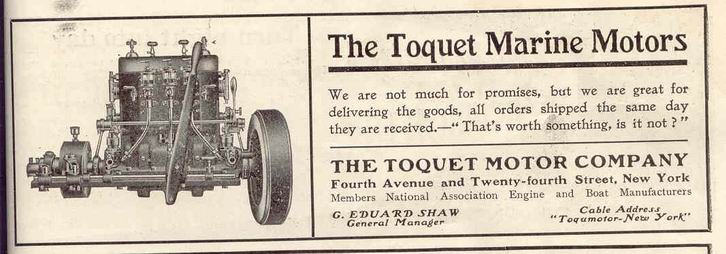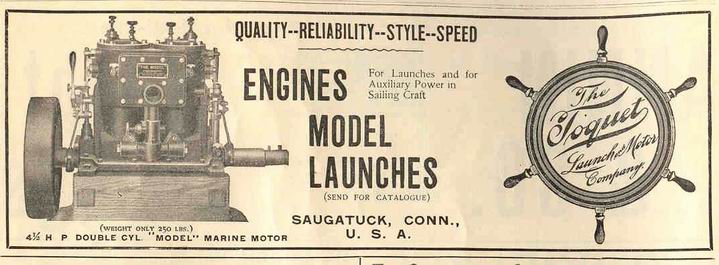| Author |
Message |
    
richardday
Senior Member
Username: richardday
Post Number: 406
Registered: 11-2003

| | Posted on Monday, May 23, 2005 - 10:44 am: | 




|
Tom Stranko deserves a big ATTA BOY!!! See his article in the June 2005 Gas Engine Magazine of his restoration of his "Emmons" "out" of "Toquet"out" of "Stanley". Apparently "Emmons" was a "Stanley" rebadged as Emmons. What the precise relationship of Stanley and Toquet isn't known to me but they clearly both operated around Boston in the early 1900s. One name should be added to the mix and that is Pierce of Pierce, NYE and Budd of early boat racing engine fame. According to the April 1909 Power Boating magazine Pierce and company are credited with mixing oil in the gasoline to lubricate two cycle engines. Power Boating refers to this "daring innovaton". It clearly marked the shift away from drip oilers and dripping oil into a cold intake manifold as a means to lubricate these relatively cold running
engines. Within a couple of years essentially all two cycle engine makers picked up the idea and the festoon of lubricators disappears from their engines. Must have been a real shock to the makers of drip oilers. Palmer Bros. were not the originators of the oil/fuel mix idea but they were quick to adopt it and by 1910 their two cycle engines were equipted with a tag warning to mix oil a pint to five gallons of gasoline. Their two cycle engines also while retaining the various pipe threaded bosses for installing lubricators remained on their engines but typically plugged. This was apparently so a customer that insisted on dripping oil could do so but at his own risk.
The one prominent maker at that time that never agreed to the oil fuel mix practice was J. W. Lathrop. His engines came with lubricators and a special and unique pump oiler that when starting the engine the owner would pump a few squirts of oil onto the crank and connecting rod in the crankcase. The problem of almost weekly cleaning of the lubricator glasses so one tell if there was any oil much less any oil dripping and how much was just too much trouble for working watermen. They just switched to mixing oil in the fuel and most probably removed the oil drippers. This also may explain why so few early Lathrops turn up with a unique crankcase oil pump for each cylinder.
As I understand these matters one other engine belongs in this family of related engines. It is the Smalley which started in Boston but moved with Pierce to Bay City MI. I believe Pierce was involved in all three engine designs. Pierce in later years went on to become a prominent automotive engine designer. |
    
richarddurgee
Senior Member
Username: richarddurgee
Post Number: 765
Registered: 11-2001

| | Posted on Monday, May 23, 2005 - 02:56 pm: | 




|
Dick
This is a 1908 ad. Stanley was manufacturing the Toquet engine at that time, Emmons has traits of both. My Notes say that Specialty Manufacturing Co. of Norwalk Conn. took them over in 1911 and that Sutter Brothers Mfging Took them over by 1921.
 |
    
thomas
Senior Member
Username: thomas
Post Number: 261
Registered: 07-2002

| | Posted on Tuesday, May 24, 2005 - 09:36 pm: | 




|
I have scanned all the ads I have (orig or Xerox) for Toquet, Stanley and Emmons. Now, I have NOTHING like (what I imagine) are the tractor trailer loads of early "Power boating" and "Motor boatin" mags that Richard has :-)
but I can tell you from what I have scanned that Toquet was around years before Stanley (or at least they advertised years before). I have 1902 scans of Toquet but no Stanley ads for years afterward. Maybe Stanley was formed just to "take over" Toquet? |
    
richarddurgee
Senior Member
Username: richarddurgee
Post Number: 770
Registered: 11-2001

| | Posted on Tuesday, May 24, 2005 - 11:31 pm: | 




|
Tom
You may be on to something here, this is a 1906 ad, without the reverse gear does it look just like the Stanley ad above ?
 |
    
thomas
Senior Member
Username: thomas
Post Number: 262
Registered: 07-2002

| | Posted on Wednesday, May 25, 2005 - 09:34 am: | 




|
If you study the Toquet and Stanley construction details you do not see any wildly inovative changes put forth by Stanley. They used the same ignition, water pump, timing adjust etc. As I pointed out in the article, the only thing they seemed to change right away was the odd Toquet mixers (they went to Schebler) and they made all the heads water cooled. It appears that they even kept the "cast-en-block" construction of the cylinder and head units on multi cylinder
engines. Richard: what is the earliest ads for Toquet and Stanley you can find?? |
    
richarddurgee
Senior Member
Username: richarddurgee
Post Number: 775
Registered: 11-2001

| | Posted on Wednesday, May 25, 2005 - 12:36 pm: | 




|
Tom
This 1902 Toquet ad is earliest I have !

The Stanley ad 1908 above is also earliest I have ! |
    
thomas
Senior Member
Username: thomas
Post Number: 266
Registered: 07-2002

| | Posted on Wednesday, May 25, 2005 - 01:40 pm: | 




|
I have Toquet ads from 1902 03, 04 and 06. The 2,3,4 ads show a Conn. address; the 06 ad has a NYC address. I can't locate it but I would swear
I have a 1906 Stanley ad. I do have Stanley ads from 1908-1911 with a Boston address. Late in
1911 and then on through to 1916 their address
was Salem, Mass.
(that 1902 Toquet ad is the one I have in Xerox.
could you email me a higher quality scan off line??) |
    
keith
Senior Member
Username: keith
Post Number: 192
Registered: 02-2002

| | Posted on Thursday, May 26, 2005 - 09:32 am: | 




|
This is the tag on the Stanley that I have. It is identical to Tom's Emmons. Where does Lawrence, Mass fit into the picture?
 |
    
richarddurgee
Senior Member
Username: richarddurgee
Post Number: 776
Registered: 11-2001

| | Posted on Thursday, May 26, 2005 - 10:14 am: | 




|
Keith
Stanley Co. business and sales office was in Boston, The actual factory was in Lawrence Mass ! |


